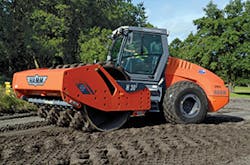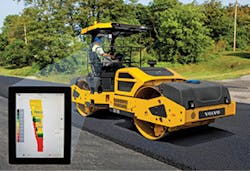Intelligent compaction is changing the way grading and excavator contractors do road compaction jobs. While industry experts agree there is no substitution for “old school” skill and touch, intelligent compaction is increasingly coming into play with many states writing the new technologies into their regulations.
According to information from Volvo Construction Equipment, intelligent compaction guidelines were established in Europe in the early 1990s. While dramatic improvements have been made to hardware, the principle of intelligent compaction remains unchanged.
Intelligent compaction is changing the way grading and excavator contractors do road compaction jobs. While industry experts agree there is no substitution for “old school” skill and touch, intelligent compaction is increasingly coming into play with many states writing the new technologies into their regulations. According to information from Volvo Construction Equipment, intelligent compaction guidelines were established in Europe in the early 1990s. While dramatic improvements have been made to hardware, the principle of intelligent compaction remains unchanged.Tim Kowalski, Hamm application support manager for Wirtgen America, notes there have been a lot of changes in the past 20 years in rollers and how they are regarded because of the type of road mixes with which contractors must contend.
In the United States, the US Federal Highway Administration (FHWA) and Transportation Pooled Fund initiatives began in 2008 and continued until 2012. Presently, the FHWA “Every Day Counts” initiative includes an intelligent compaction component.“The biggest factor is educating the operators on the new technology and how to use it to their advantage to get the most out of it and make a better product in the process,” he adds.
Newer systems are gradually and fundamentally changing how contractors test soils, aggregate bases, and asphalt, among other factors, notes Dann Rawls, marketing consultant for Caterpillar’s technology enabled solutions group.
“The whole industry is trying to change how we look at testing, because you can’t compare a roller that’s testing load bearing to a density gauge that’s testing density,” he says. “There’s really no correlation between density and load bearing. Ground stiffness and load-bearing capacity is fundamentally different than density.
“When we start looking at load-bearing testing, we’re starting to move into different testing devices that match what the machines are actually measuring. These systems are changing out the whole industry, specifically in quality control and quality assurance.”
Consider the options: Volvo Intelligent Compaction (IC) by Volvo Construction Equipment is expected this fall to introduce real-time density mapping technology designed to eliminate guesswork, improve quality, and increase productivity.
Volvo IC and Volvo IC with Density Direct will initially be available for new Volvo asphalt compactors—the Volvo DD110B, DD120B, and DD140B models sold in North America—with aftermarket availability for Volvo asphalt compactors to follow.
In addition to offering the pass mapping, temperature mapping, and data storage features of the Volvo IC system, Volvo IC with Density Direct includes the industry’s first real-time density mapping technology.
“Density mapping has been described as the ‘holy grail’ of intelligent compaction,” notes Fares Beainy, Volvo Construction Equipment research engineer, adding that the technology is expected to “radically advance the paving industry.
“For years, contractors have relied on IC systems with stiffness calculations (through Compaction Measurement Value or CMV) instead of density, which is not the true metric by which contractors are evaluated and paid,” adds Beainy. “With Density Direct, operators have real-time access to the metric that ultimately determines the success of their work—density.”
Stiffness measures the rigidity of the asphalt surface and provides an output in CMV. Contractors use nuclear gauge measurements and core samples throughout the course of a job to correlate the CMV to the relative density in contrast to Density Direct, offering the operator relative density in real time.
The system includes a display, an accelerometer, front and rear infrared mat temperature sensors, a GPS, a base station, and an optional GPS Rover.
The Volvo IC with Density Direct user interface depicts a density map showing each square foot of rolled asphalt in a color representing density and provides a real-time numerical density reading displayed in the corner of the screen.
Using the cab-mounted Volvo IC system 8-inch by 10-inch color monitor with pinch/zoom and day/night mode, the pass mapping function captures each compactor pass and drum overlap with an individual color so that the operator can easily see gaps and work to maintain uniform coverage.




